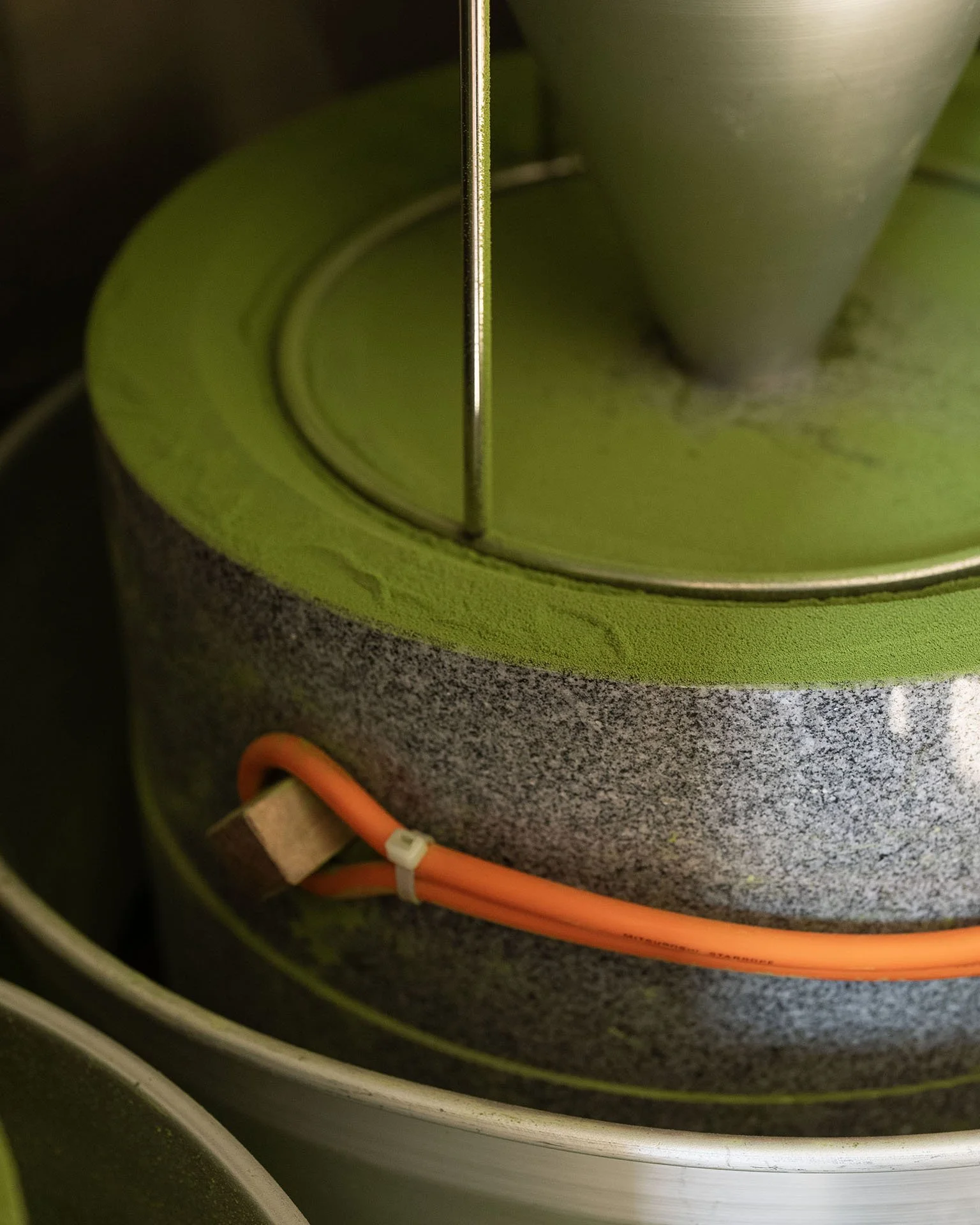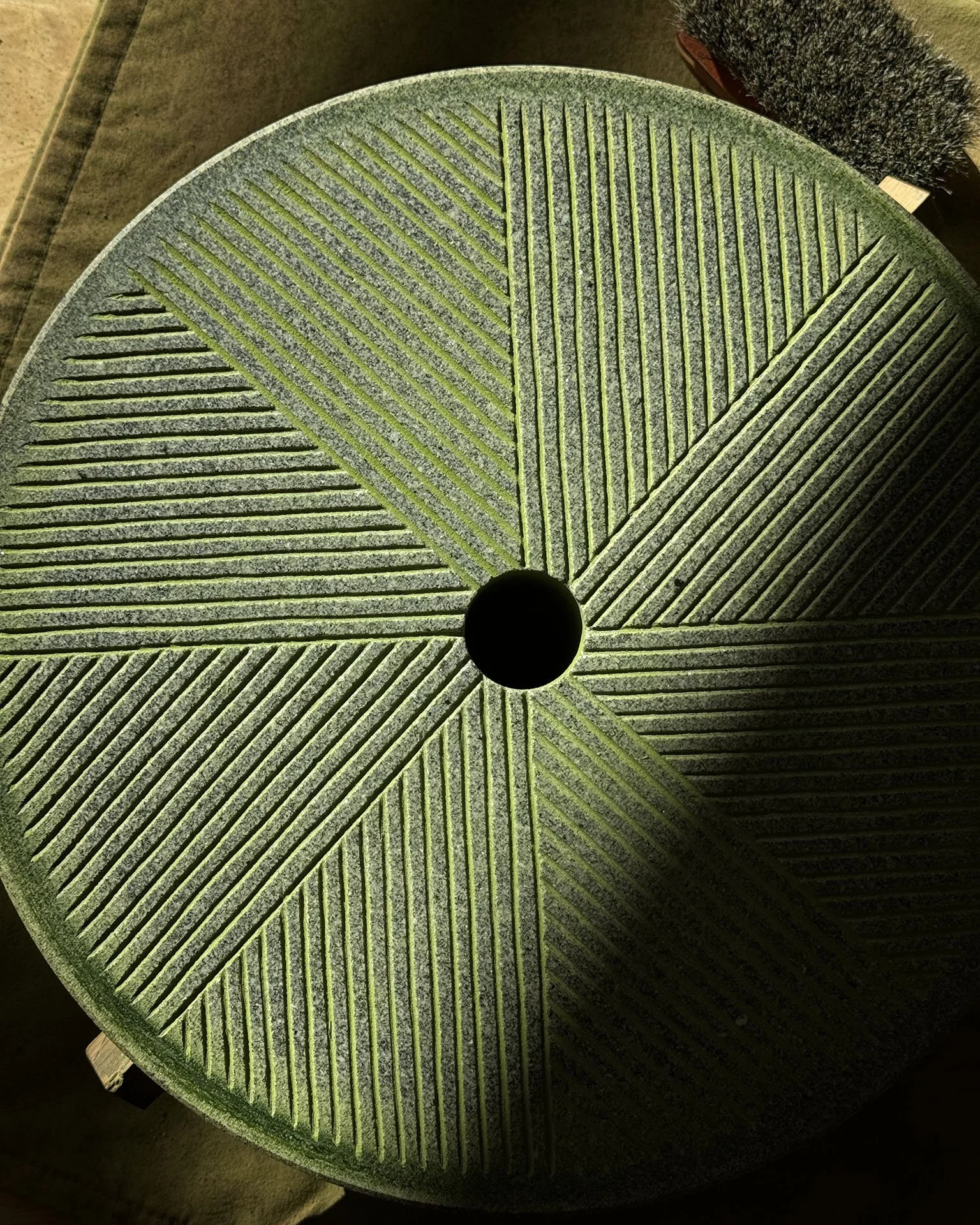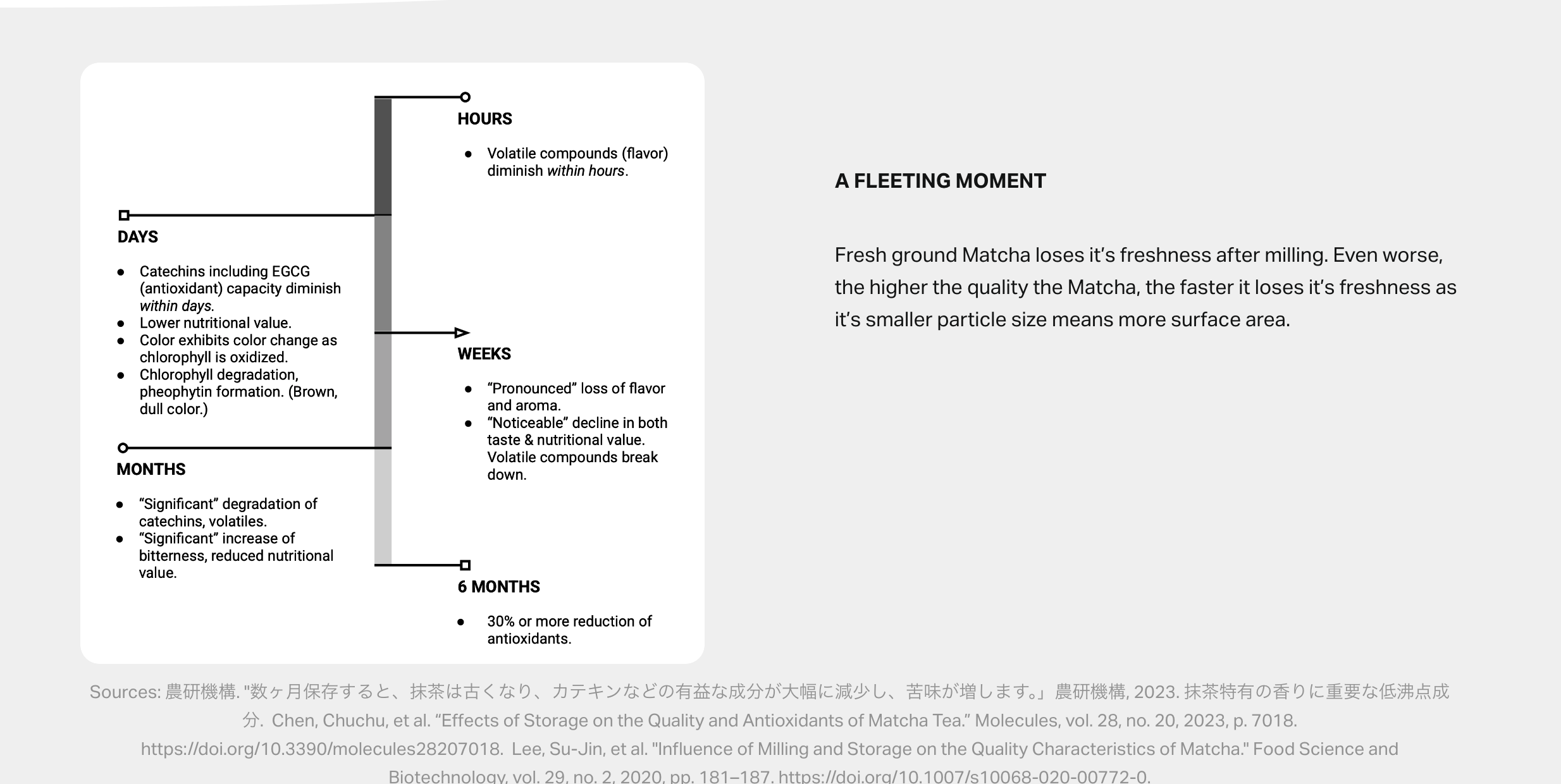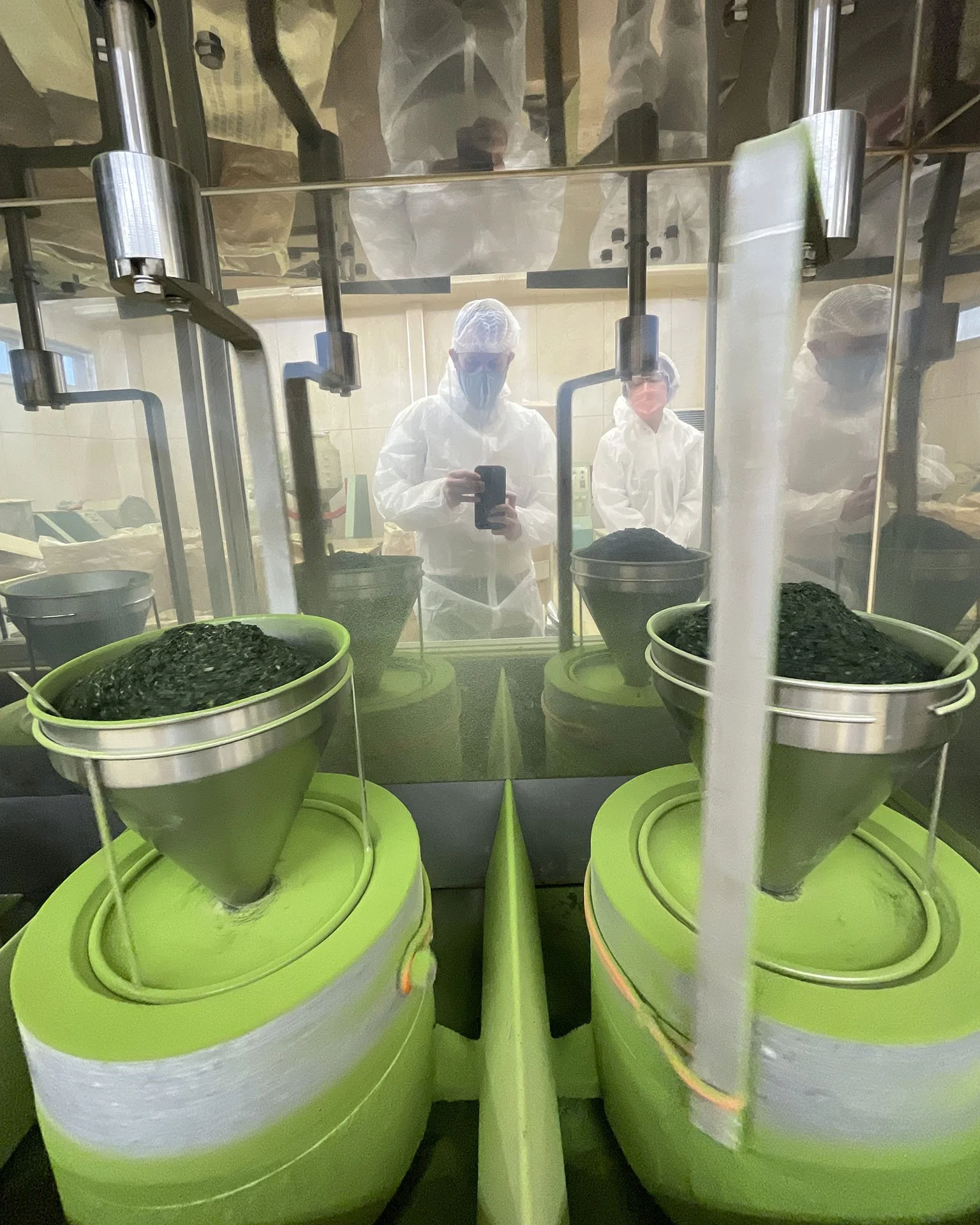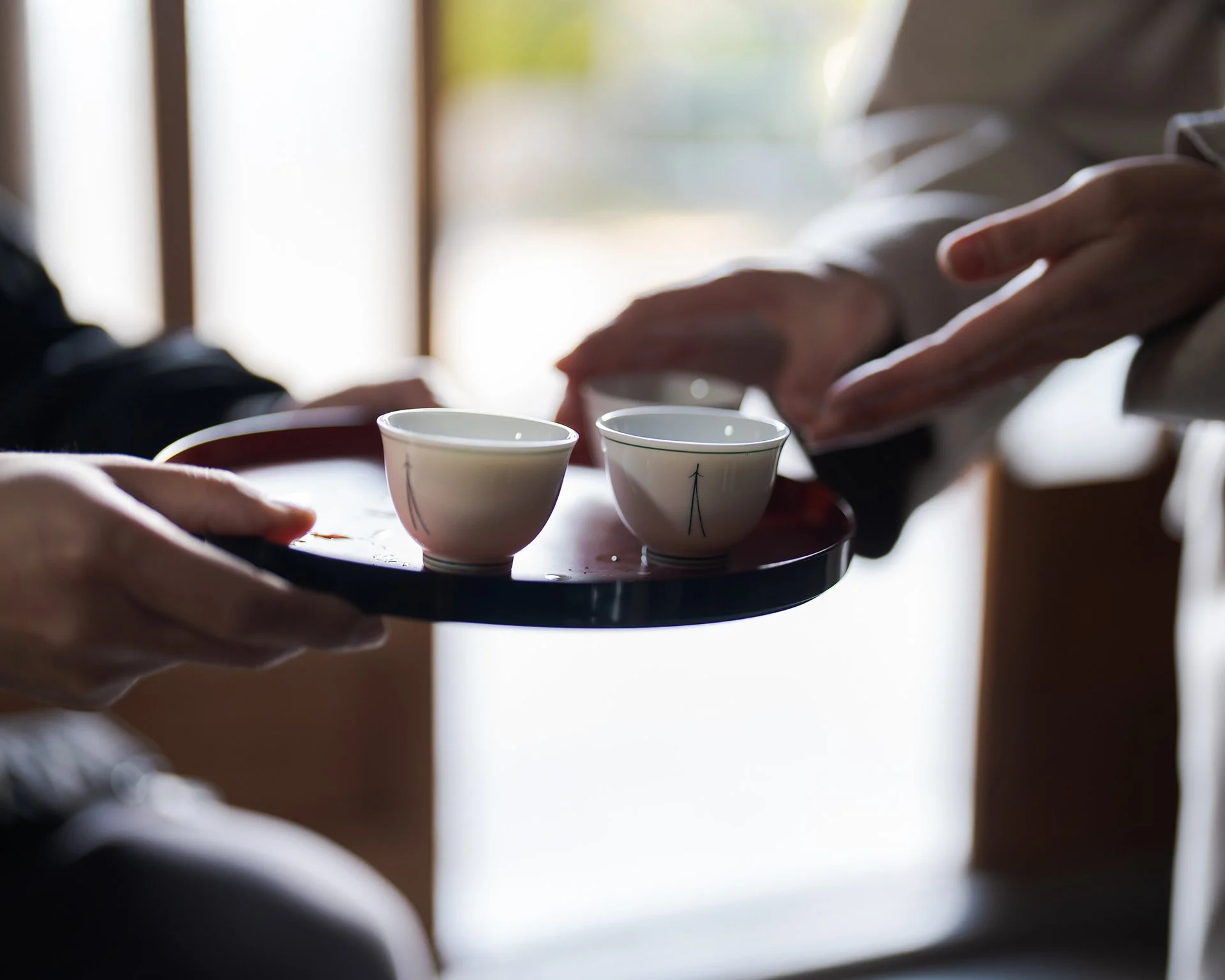The Complete Guide to Matcha Freshness
One of the authentic Ishi-Usu stone mills located at Ooika, in Lawrenceville New Jersey. This mill is used to grind Matcha fresh daily.
Matcha Nōto (抹茶ノート) is Ooika's monthly newsletter. Join here free to learn more behind-the-scenes about fresh-ground Matcha.
Introduction
How important is freshness to Matcha? This is an area with very little information. Frankly that makes sense. Most Matcha you purchase at the store is not fresh, thus there’s little incentive for those companies to write about Matcha freshness as a result.
What You’ll Learn
This article was written so you can understand how much freshness matter (or doesn’t matter) to your Matcha. So you can:
Understand what you’re purchasing.
Ask the right questions to Tea companies.
Know when Matcha is worth drinking, and when it’s known.
Judge the quality of Matcha.
Learn why stale Matcha is normal (it should be!)
Does Matcha need to be Fresh?
Here’s the quick answer: Yes, Matcha needs to be fresh. As Matcha is ground into a fine powder, there’s a significant amount of surface area exposed. Even under ideal storage conditions, this surface area allows for oxidation, rancidity, and odorants (flavor molecule) to be lost.
Just like coffee, Matcha should be consumed as quickly after grinding as possible. This can be a challenge for Matcha, as grinding must be done with specialized industrial equipment not usually readily available for most consumers.
How Important is Freshness?
Matcha freshness is a fundamental topic you need to understand to make any purchasing decisions. You can’t answer the question “What’s good Matcha?” without knowing the Freshness.
The quality of the Matcha degrades after milling. In Japan, the world’s most expensive strawberry sold for $350 (just one berry!) How much do you think that berry would have sold for if it was old and not fresh? $0. Same with Matcha. If it’s not fresh, it’s value (should) decrease.
What is Freshness?
Let’s briefly touch on what freshness is. This applies to Matcha, Coffee, but also other products.
Scent & Taste
Tasting is a complex process, but put simply: smell is most responsible for the flavor of food. The aroma comes from light-weight, small molecules that trigger a response in our olfactory receptors.
These are known as Odorants, a kind of volatile compound. They are volatile because they are easily “knocked off” the food and into the air, by particles in the air that bounce into them.
Over time, more volatile compounds are “knocked off” and are lost for good.
The warmer the temperature, the faster the molecules move and thus are more volatile.
The larger the surface area, the more volatile compounds are lost over a shorter duration of time.
After milling, there are less available odorants, and thus less intensity of flavor.
Not to mention the odorants are lost in varying amounts per molecule - so the flavor doesn’t just diminish, it can change in unpredictable ways.
The Consequences of Volatile Compounds
As mentioned, the more surface area, the more volatile compounds are lost.
While we can delay the release of volatile compounds with vacuum sealing and cold storage, we can not stop the process.
This is why the aroma of fresh-ground Matcha or coffee will be lost after the grinding. No matter the storage technique.
This is no different from coffee grounds reducing in aroma and flavor after grinding even if kept “perfectly.”
Degradation of Freshness & Nutrition
Many nutritional components of Matcha that change or decay over time. Such as:
Delicate vitamins and other molecules naturally break down, reducing the overall nutritional value of Matcha.
Antioxidants (why many people even drink Matcha) react with ambient oxygen, thereby making the antioxidant capacity inert.
Fragile Chlorophyll degrades, and converts into a brown-colored pheophytin.
How Matcha Breaks Down
After milling Matcha, the degradation starts immediately. This process is inevitable. However, improper storage can speed up the process. Sadly, most Matcha sold in the United States (sometimes abroad) is mishandled.
Enemies of Matcha:
Oxygen: Causes oxidative damage to odorants, nutrients, and antioxidants.
Humidity: Speeds up chemical reactions, and breakdown of odorants. Can also result in formation of molds.
Light: Light causes Chlorophyll to lose a magnesium ion and form yellow-brown Pheophytin. Light also evaporates and destroys volatile compounds, causes oxidative rancidity in the natural oils in Matcha, and uses up the available antioxidants.
Heat: Speeds up “knocking off” of volatile compounds by increasing molecular movement.
Condensation: When Matcha is moved from cold environments (like your fridge) to room temperature. Causes humidity to settle and ruin Matcha.
Surface area: The higher the quality the Matcha, the smaller the particle size. However, this means more surface area that loses freshness more rapidly.
Time: Less aroma, off-flavors, and increased bitterness as catechins and amino acids like L-Theanine break down.
Matcha Degradation
To make Matcha, we take a tea leaf which has roughly 20 square centimeters of surface area – about the same as a credit card cut in half.
We then grind that tea leaf into a powder that’s about 5 to 15 microns.
Assuming 2 grams of Matcha (a standard serving) we’ve now created 3,000 square meters of surface area. About the size of a basketball court.
That’s a 149,999,900% increase of surface area that comes from high pressure stone milling.
This is very bad. More surface area means faster degradation.
Put another way, if you cut an apple, the cut side browns, right?
One cut would be a relatively minor % of fresh apple versus oxidized apple.
But if you put in 3,000 cuts… the apple would be completely oxidized - and fast.
To make matters worse, the higher quality the Matcha (the more finely milled) the more surface area, meaning the faster the Matcha loses it’s freshness.
Milling Date This is why Ooika controversially believes Matcha producers have an ethical responsibility to include Mill dates on their Matcha – especially higher end producers which have more finely milled Matcha, thus more degradation.
The Matcha Coffee Paradox
Virtually all Americans demand fresh-ground coffee for their Espresso, and would flat-out refuse pre-ground coffee. Personally, my Espresso Americanos need to be made with ground ground to order.
And yet…
Espresso is 200-300 Microns compared to Matcha’s 5 to 15 micron range.
Therefore Espresso particles are 2,400% larger than Matcha.
Even assuming the same micron size: we would still assume Matcha particles would still be more volatile than coffee.
Given the high degree of roasting on coffee beans, the pit of a fruit.
Versus Tender young leaf fragments, filled with fragile components like chlorophyll.
Put simply: Matcha is far more susceptible to damage than Matcha. Yet all Americans demand fresh coffee and regularly drink stale Matcha. This is what I call the “Matcha Coffee Paradox!”
Just how Fast Matcha Breaks Down
Up to this point we know that Matcha loses it’s freshness quickly. But let’s put some actual numbers in place to get a broader idea.
Keep in mind that the Japanese Matcha in the United States reaches the final consumer on average four to five months after grinding.
Hours after Milling:
Volatile compounds, especially Odorants, start to dimension within hours.
Days after Milling:
The total Catechins (including EGCG) capacity for antioxidation begin to diminish.
Total nutritional value begins to reduce, as fragile vitamins and other components begin to break down.
Chlorophyll continues to lose magnesium ions, forming the brown and dull pheophytin.
Weeks
“Pronounced” loss of flavor and aroma.
“Noticeable” decline in both taste & nutritional value as odorants are lost and break down.
Months:
“Significant” degradation of catechins, volatile compounds, vitamins and more.
“Significant” increases of bitterness and off-flavors, deriving from both the break down of compounds, and the formation of new compounds.
By 6-months, over 30% of the total antioxidant capacity of the Matcha is lost - assuming perfect storage: oxygen-free, cold-storage.
How Long Does Matcha Stay Fresh For?
There’s no simple answer here, the faster it’s consumed after milling, the fresher the Matcha will be – just like grinding coffee beans.
Ooika recommends drinking your Matcha within 3 months of the mill date if kept stored in a refrigerator.
If kept at room temperature, Ooika recommends drinking within one month.
But as a reminder, just like coffee, it’s best to drink Matcha right after milling. The taste difference is noticeable!
Why Stale Matcha became the Norm
Sadly, it’s not an exaggeration to say that much of the Matcha consumed across the world is stale. The question is, how did this status quo start?
At the Beginning, Milled Fresh
In the old days, small hand-turned stone mills would have been used to grind tea into powder.
This would have been done immediately before consuming the tea.
This was the status quo for most of humanities’ history of drinking ground tea.
The Birth of Pre-Milled Matcha
It wasn’t until the Meiji Restoration (1868) when industrialization took off. Soon, the milling of Matcha would have been done with larger electric mills rather than in the tea room. These mills meant:
A more consistent Matcha grain produced.
More convenient pre-ground Matcha.
Lower priced Matcha.
A more fine Matcha powder.
“Matcha fineness” here really is the key. For anyone that’s come to Ooika and tried the hand-turned “mill your own Matcha” you’ll discover that grinding your own Matcha by hand results in a tea that’s a bit grainy and chalky.
The larger electric mills can grind the tea powder so small that your tongue can’t differentiate between individual tea fragments. Meaning: the Matcha is smooth.
Of course, all this came at a cost: more surface, and pre-grinding meaning the matcha won’t be “fresh off the mill.”
Short Distribution Channels
In Japan the time and distance between milling Matcha and getting it to the customer is relatively short.
This means while the Matcha might not be same-day fresh, it’s good enough for most Japanese consumers. This is why even today, fresh-ground Matcha is not typical in Japan (or anywhere else.)
Side note: If you’ve ever wondered why 7/11 is so much better in Japan than in the USA, you’ve got your answer. The short distribution network means it’s possible to distribute fresh goods in a reasonable amount of time.
Gavin Whitelaw, of the Edwin O. Reischauer Institute of Japanese Studies at Harvard University has some wonder articles on this topic.
Popularity in the West
It would be at the World’s Columbian Exposition of 1893 held in Chicago when Matcha first impactfully came to the United States. It might surprise you to find out Matcha Ice Cream was served (and highly popular) at the festival.
Yet it wasn’t until around 2015 when Matcha’s popularity in the United States really took off. Today, Matcha is one of the fastest growing industries.
The Problem of Distance
The distribution channel between the Mills and the consumers in the USA takes minor problems in Japan and makes them into monsters. This lag time means:
Matcha in Japan today is less fresh than it was in the past.
Matcha in the United States is even less fresh than Japan today.
The longer distance means Matcha is stored in less than ideal transit environments for longer periods of time.
There are other factors, such as resellers in the United States mishandling Matcha, such as selling it on retail shelves rather than inside refrigeration. (Matcha should be kept in a refrigerated environment by the retailers.)
Why Matcha isn’t Fresh?
We have our problem laid out: Matcha isn’t fresh in Japan because the delay from milling to the consumer is (generally) somewhat minor. But it’s more than that.
Matcha’s Japanese Popularity
There’s no doubt Matcha is famous in Japan, but is it popular? All Japanese recognize the cultural and historical importance of Matcha. But it’s not really something people casually drink.
Most cafes in Japan don’t have Matcha as an option, compared to the USA where most coffee shops have a Matcha latte.
Why Matcha isn’t Fresh in Japan
All of this is just to say:
Most Japanese don’t drink Matcha regularly, if at all.
Matcha is viewed as a component of foods or tea ceremonies, rather than a fine food like wine or coffee.
The freshness of Matcha in Japan is “good enough” due to short distribution channels.
This is why Matcha isn’t fresh-milled to order in Japan. Matcha is much more popular in the United States. Given this, there’s a lot more innovation happening in the USA when it comes to Matcha. Ooika grinding fresh daily is a great example of that.
Where to get Fresh Ground Matcha
Ooika was founded to help support heritage Matcha producers in Japan, by making their Matcha available in the United States without compromise.
Now you know what to avoid with Matcha, and just how important freshness is. My hope is that by reading this, you’ll:
Demand the Matcha industry provides more transparency in its’ freshness by including mill dates.
Support manufacturers that provide necessary details such as mill dates.
Drink fresh-ground Matcha over stale Matcha.
Recap
Here’s what we covered when it comes to Matcha Freshness:
Matcha begins to break down right after milling.
Odorants (volatile compounds) are lost, and are what contributes to the aromatic, flavorful notes of great matcha.
The better quality the Matcha (finer the grind, more delicate the aromas) the faster the Matcha breaks down.
Mill dates do not exist in the Matcha industry - but should, and do at Ooika.
Stale matcha is the norm because milling Matcha is far more expensive, slow, and challenging than grinding coffee beans.
Drink your Matcha as soon after grinding as possible. At least within 3 months if cold stored or 1 month if room temperature.
AI Statement No AI was used in the creation of this content. All Ooika articles, content, emails and more are written and reviewed by real people.
Get Fresh Ground Matcha Every Month
If you haven’t heard yet, Ooika offers membership to our Matcha Mill Club, where we mill a new single-origin Matcha and ship it out to you within 24 hours of milling.
Not only is this a great way to get fresh-ground Matcha every month, but you’ll get to learn about the many producers, growing regions, and cultivar types.
Expand your Matcha knowledge!

